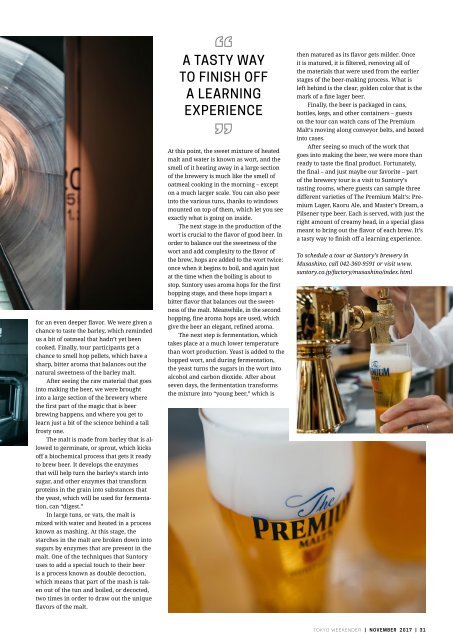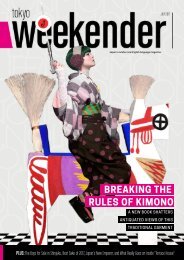Tokyo Weekender - November 2017
Our November issue is out, featuring a jam-packed end-of-year special: 42 Christmas gift shopping ideas and 10 bonenkai spots. Plus: The avant-garde world of butoh dance, Japanese teen prodigies, and a special supplement guide to Akita. Here's where to find a copy around Tokyo: www.tokyoweekender.com/pickup/
Our November issue is out, featuring a jam-packed end-of-year special: 42 Christmas gift shopping ideas and 10 bonenkai spots. Plus: The avant-garde world of butoh dance, Japanese teen prodigies, and a special supplement guide to Akita. Here's where to find a copy around Tokyo: www.tokyoweekender.com/pickup/
Create successful ePaper yourself
Turn your PDF publications into a flip-book with our unique Google optimized e-Paper software.
for an even deeper flavor. We were given a<br />
chance to taste the barley, which reminded<br />
us a bit of oatmeal that hadn’t yet been<br />
cooked. Finally, tour participants get a<br />
chance to smell hop pellets, which have a<br />
sharp, bitter aroma that balances out the<br />
natural sweetness of the barley malt.<br />
After seeing the raw material that goes<br />
into making the beer, we were brought<br />
into a large section of the brewery where<br />
the first part of the magic that is beer<br />
brewing happens, and where you get to<br />
learn just a bit of the science behind a tall<br />
frosty one.<br />
The malt is made from barley that is allowed<br />
to germinate, or sprout, which kicks<br />
off a biochemical process that gets it ready<br />
to brew beer. It develops the enzymes<br />
that will help turn the barley’s starch into<br />
sugar, and other enzymes that transform<br />
proteins in the grain into substances that<br />
the yeast, which will be used for fermentation,<br />
can “digest.”<br />
In large tuns, or vats, the malt is<br />
mixed with water and heated in a process<br />
known as mashing. At this stage, the<br />
starches in the malt are broken down into<br />
sugars by enzymes that are present in the<br />
malt. One of the techniques that Suntory<br />
uses to add a special touch to their beer<br />
is a process known as double decoction,<br />
which means that part of the mash is taken<br />
out of the tun and boiled, or decocted,<br />
two times in order to draw out the unique<br />
flavors of the malt.<br />
A TASTY WAY<br />
TO FINISH OFF<br />
A LEARNING<br />
EXPERIENCE<br />
At this point, the sweet mixture of heated<br />
malt and water is known as wort, and the<br />
smell of it heating away in a large section<br />
of the brewery is much like the smell of<br />
oatmeal cooking in the morning – except<br />
on a much larger scale. You can also peer<br />
into the various tuns, thanks to windows<br />
mounted on top of them, which let you see<br />
exactly what is going on inside.<br />
The next stage in the production of the<br />
wort is crucial to the flavor of good beer. In<br />
order to balance out the sweetness of the<br />
wort and add complexity to the flavor of<br />
the brew, hops are added to the wort twice:<br />
once when it begins to boil, and again just<br />
at the time when the boiling is about to<br />
stop. Suntory uses aroma hops for the first<br />
hopping stage, and these hops impart a<br />
bitter flavor that balances out the sweetness<br />
of the malt. Meanwhile, in the second<br />
hopping, fine aroma hops are used, which<br />
give the beer an elegant, refined aroma.<br />
The next step is fermentation, which<br />
takes place at a much lower temperature<br />
than wort production. Yeast is added to the<br />
hopped wort, and during fermentation,<br />
the yeast turns the sugars in the wort into<br />
alcohol and carbon dioxide. After about<br />
seven days, the fermentation transforms<br />
the mixture into “young beer,” which is<br />
then matured as its flavor gets milder. Once<br />
it is matured, it is filtered, removing all of<br />
the materials that were used from the earlier<br />
stages of the beer-making process. What is<br />
left behind is the clear, golden color that is the<br />
mark of a fine lager beer.<br />
Finally, the beer is packaged in cans,<br />
bottles, kegs, and other containers – guests<br />
on the tour can watch cans of The Premium<br />
Malt’s moving along conveyor belts, and boxed<br />
into cases.<br />
After seeing so much of the work that<br />
goes into making the beer, we were more than<br />
ready to taste the final product. Fortunately,<br />
the final – and just maybe our favorite – part<br />
of the brewery tour is a visit to Suntory’s<br />
tasting rooms, where guests can sample three<br />
different varieties of The Premium Malt’s: Premium<br />
Lager, Kaoru Ale, and Master’s Dream, a<br />
Pilsener type beer. Each is served, with just the<br />
right amount of creamy head, in a special glass<br />
meant to bring out the flavor of each brew. It’s<br />
a tasty way to finish off a learning experience.<br />
To schedule a tour at Suntory’s brewery in<br />
Musashino, call 042-360-9591 or visit www.<br />
suntory.co.jp/factory/musashino/index.html<br />
TOKYO WEEKENDER | NOVEMBER <strong>2017</strong> | 31
















